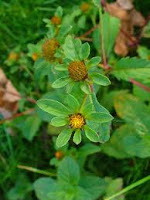This plant was called Greek valerian in Culpeper’s time – he wrote his herbal in the 17th century. Despite the name it was a native of the British Isles and the rest of Europe and parts of Asia. The flower also known as Jacob’s ladder which is native to America is Polemonium reptans also known as Abscess root. Both ate members of the Polemoniaceae family of plants, or the phlox family.
 This plant has sky-blue (caeruleum) flowers or white and is called Jacob’s ladder because the leaves, which are in pairs, rise in steps like the rungs of a ladder. The genus name Polemonium comes from the ancient Greek, polemonium meaning plant. Despite the name Greek Valerian it is not related to the true valerian (Valeriana officinalis).
This plant has sky-blue (caeruleum) flowers or white and is called Jacob’s ladder because the leaves, which are in pairs, rise in steps like the rungs of a ladder. The genus name Polemonium comes from the ancient Greek, polemonium meaning plant. Despite the name Greek Valerian it is not related to the true valerian (Valeriana officinalis). Jacob’s ladder is rare these days in Britain and there are conservation efforts underway to save it from extinction. In Culpeper’s day it was confined, he says to the mountain regions and Yorkshire. Since then it has been browsed by cattle and has suffered other setbacks due to human activity.
The plant can grow to heights of around three feet (approximately 90 centimetres) but is more normally seen growing to two feet. It sends out its leaves in April and flowers between June and September and can be harvested when in flower and dried to use in potpourris. In some countries the flower heads are boiled in olive oil and this oil is used as black hair dye.
Cats are attracted to this plant as they are to catnip, so if you grow it in your garden, beware of the feline attention it will bring.
The ancient Greeks used this plant to treat dysentery, toothache and animal bites. The part used was the root. You can make a tisane with the leaves and flowers and this was given to relieve nervousness and agitation. However the main part of the plant used in medicine was the root which was made into a tincture with whiskey.
 The plant has astringent and diaphoretic properties (it promotes sweating), and has in the past been used to treat a variety of diseases which include fevers, headaches and epilepsy.
The plant has astringent and diaphoretic properties (it promotes sweating), and has in the past been used to treat a variety of diseases which include fevers, headaches and epilepsy. Today it is little used- even in homeopathic treatments. However it was used to treat syphilis and rabies in 19th century Europe, although there is no mention of its efficacy
Nicholas Culpeper, the English herbalist writing in the 17th century has this to say about it:-
“Government and virtues. It is under Mercury, and is alexipharmic, sudorific, and cephalic, and accounted useful in malignent fevers, and pestilential distempers: it helps in nervous complaints, head-achs, trembling, palpitations of the heart, vapours, and all that train of miserable disorders, included under the name of nervous. It is also good in hysteric cases; and epilepsies have been cured by the use only of this herb.”

















